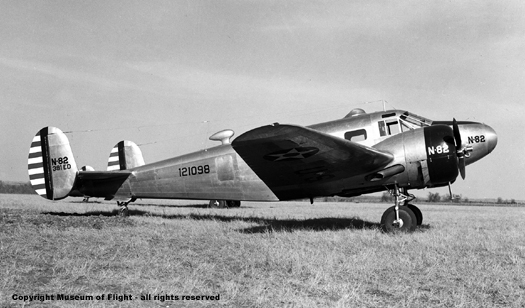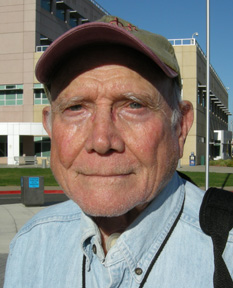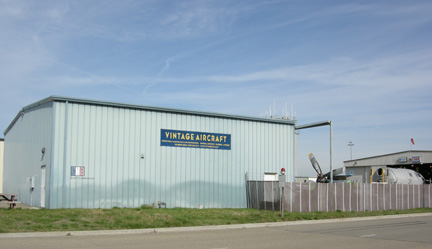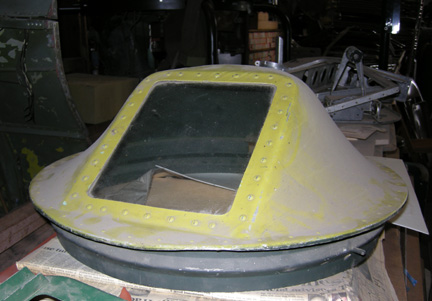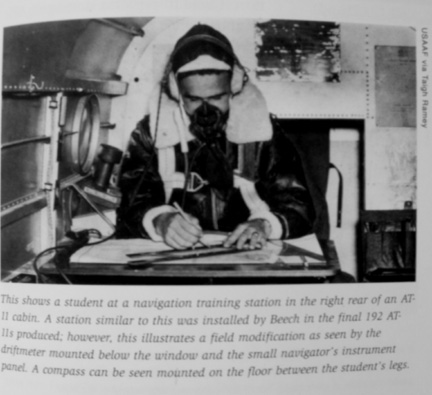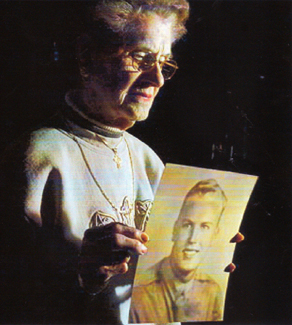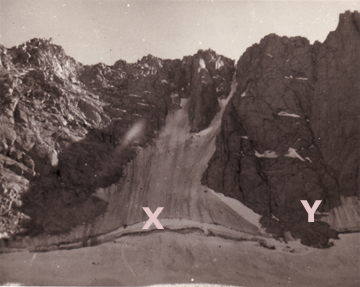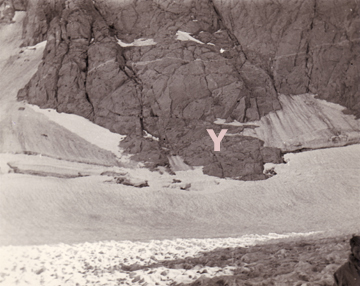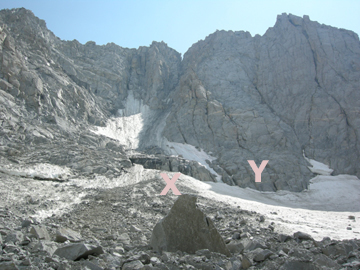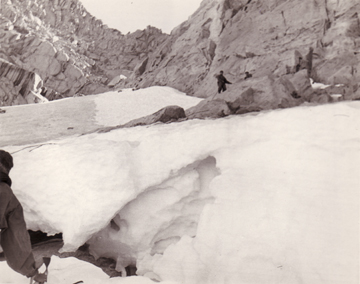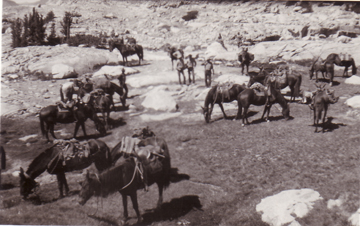|
|
||||||||||
|
Beech 18 AT-7 Navigator Copyright Museum of Flight - all rights reserved February, 2008 |
||||||||||
|
FINAL FLIGHT a blog by Peter Stekel FINAL FLIGHT is the story of four aviators lost in Sequoia & Kings Canyon National Parks on November 18, 1942 |
||||||||||
|
FINAL FLIGHT, coming from Wilderness Press in 2010 |
||||||||||
|
Read more about FINAL FLIGHT here. |
||||||||||
| February 29, 2008 I'm in Berkeley today, meeting with Roslyn Bullas, Managing Editor, and Emily S. White, Marketing and Publicity Specialist for Wilderness Press. Wilderness Press will be publishing FINAL FLIGHT in late 2009. We spent a good deal of time getting to know each other and discussed my progress in researching and writing FINAL FLIGHT. After speaking with Roslyn several times over the phone and after numerous email messages back and forth, it was great to finally meet her face-to-face. I feel comfortable working with both Roslyn and Emily. It was a pleasure to see their excitement with the book and their interest in the story. |
||||||||||
|
|
||||||||||
| February 28, 2008 | ||||||||||
| I met with Leonard Spivey today at Mather Field in Sacramento. Mather Field [named for 2nd Lt. Carl Spencer Mather, an Army Signal Corps pilot, killed in an air collision at Ellington Field, Texas in January 1918] was a large training area during World War II for pilots and navigators with the United States Army Air Forces [USAAF]. |
|
|||||||||
|
Leonard graduated [first in his class] from the navigator school in 1942. He was in the class ahead of Mortenson, Munn, and Mustonen. Through Leonard I was able to learn, and understand, a lot about navigator training at Mather. Also of interest to me was Leonard's comment about the alphabetical arrangement of the three cadets. This meant they trained together and were probably roommates as well. William Bechter was a friend of Leonard's. Bechter was in the same class as Mortenson, Munn, and Mustonen and flew on several of the search parties after 41-21079 disappeared on November 18, 1942. In William Bechter's diary for that day he wrote:
In the courtyard of the VA hospital at Mather Field is a memorial to US service personnel. Bricks, with various inscriptions are laid in the courtyard below the bronze sculpture of a soldier. There is a brick there, placed by Leonard, honoring all the Mather Field navigators killed in action [KIA]. Also, to the left, Leonard placed a brick for his good friend, William Bechter, "Who gave his happy youthful life fighting to free Europe of the horrors of Hitler's Naziism." William Bechter was killed in action in France, July 14, 1943.
|
||||||||||
| February 27, 2008 I'm staying with friends in Sacramento and this morning made my way down to Stockton to visit with Taigh Ramey. He is the owner of Vintage Aircraft and specializes in restoring the Beech 18. Since the AT-7 piloted by Lt. Gamber was a Beech 18 it was a no-brainer for me to meet with Taigh. As far as I can tell, Taigh knows more about the engines and structure of the Beech than anyone else in the world. I showed him my crash photos from last summer on Mendel Glacier and he could recognize every piece he saw. Amazingly, Taigh could look at individual pieces and know exactly from what part of the aircraft they came from. |
||||||||||
|
|
||||||||||
| We spent quite a bit of time discussing
whether Lt. Gamber's ship flew into the mountain, crashed [while turning
or attempting some other kind of maneuver], or ran out of fuel and fell
from the sky. There isn't enough data to say one way or another. As Lt.
Col. Tom Betts told me, reported in an earlier blog posting, it will be
important to find the propellers and the instrument panel to narrow down
the choices. Meantime, Taigh feels strongly that the engine damage
suggests that the Beech was going at speeds in excess of its normal
cruising speed - greater than 140 mph. Taigh has quite a few Beech 18s in various stages of repair or restoration. He was currently working on an AT-7 variant that had been formerly in the Canadian Air Force. After being surpluses it came into the ownership of a private party who was now interested in making it fly again. |
||||||||||
|
|
||||||||||
| For me, the best part of seeing Taigh's collection was getting an appreciation for just how small the cockpit and fuselage of the Beech is. From the outside it looks like a large airplane but the body tapers quickly towards the rear, making the interior cabin space very cramped. The students, crammed to the starboard side of the aircraft, sitting at their desks, would have been very cramped. A trip to the cockpit would have been a wonderful excursion, small as it was, to stretch out. | ||||||||||
|
|
||||||||||
| All in all it was a great visit and I greatly appreciate the time Taigh spent with me. I know so little about aviation that I'm always having to change or re-evaluate my thoughts, theories, and conclusions as I learn something knew. From Taigh I was able to get a copy of the pilot's flight operating instructions for the AT-7 from May 25, 1944 [revised February 15, 1945] and I look forward to reading through it for design or mechanical clues as to what may have contributed to the crash. | ||||||||||
| February 25, 2008 I'm on my way to California this afternoon for a couple of weeks to meet with people and conduct interviews. I will post updates as time permits. |
||||||||||
| February 24, 2008 See this article, "Dedicated Stranger Gets Ohio Man Home," in the Columbus Dispatch. The columnist, Mike Harden, really captures how I feel about the FINAL FLIGHT project. Also available here if the first link doesn't work. |
||||||||||
|
February 18, 2008 - Glenn Munn in the news Lois Shriver, a younger sister of Glenn Munn was interviewed on KDKA, Pittsburgh on February 14. See HERE - not sure how long they will keep making it available. |
||||||||||
| February 11, 2008 - Ernest Glenn
Munn identified The family of Ernest Glenn Munn was notified by the US Military Repatriation Department on Friday, February 8, that the second person found on Mendel Glacier is Cadet Ernest Glenn Munn.
|
||||||||||
|
Glenn's sister, Lois Shriver, holds his portrait |
||||||||||
| Official notice by JPAC will come after the family accepts the identification. See HERE [Spokane Spokesman-Review] and HERE [Fresno Bee] and HERE [Seattle Times] and HERE [WTRF-TV] and HERE [WTOV-TV] for news reports. Glenn Munn has an entry on Wikipedia HERE. Leo Mustonen has an entry on Wikipedia HERE. | ||||||||||
| February 8, 2008 - Ice
9 and climbing the Mendel Couloirs Seen from Lamarck Col to the east, 13,710 foot Mt. Mendel forms a classic Sierran cirque. Filling the upper bowl of the cirque is the Mendel Glacier. Below it and to the sides are a terminal moraine and two lateral moraines forming a horseshoe of steeply piled rocks pushed there by the glacier. In the middle of this landscape appears to be concentric rings of glacial debris topped with piles of rock that have fallen from the surrounding cliffs. A photo taken by G.K. Gilbert in 1908 shows the entire basin to be filled with ice and snow. Due west in the cirque, a shoulder of Mt. Mendel drops into the basin, forming a deep crease in the head wall. Glacial ice piles up in a big hump and ascends the crease to where it becomes a low-lying gully. This gully is filled with all sizes of broken rock. Often snow and/or ice-filled, the gully ascends to the ridge. To the south, another steep field of ice ascends skyward, directly below the summit of Mt. Mendel. Maybe half-way up, this ice apron splits in two. Separated by a huge mass of rock, there is a very narrow right couloir and an even skinnier left. Photos from 1947 and 1948 show a bergschrund below the ice apron where a cliff band existed in 2007. The same 1940s photos also show a piece of bergschrund right [west] of the apron, a tiny piece of which we could see in 2007. |
||||||||||
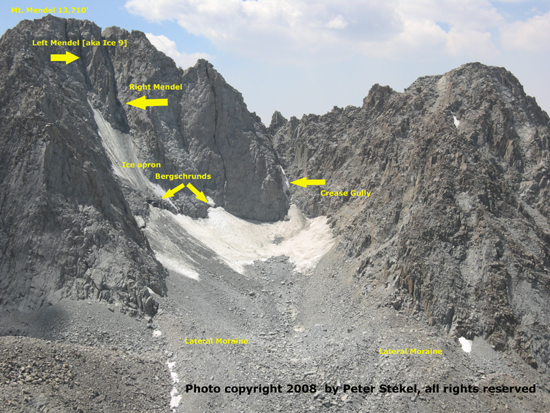 |
||||||||||
|
Mt. Mendel and the Mendel Glacier from Lamarck Col It seems to me there has always been confusion about what constitutes which climb in the Mendel Couloir. At first, because I was confused by descriptions of where Ice 9 and the Left and Right Mendel Couloirs were situated, I thought the gully caused by a crease in Mt. Mendel constituted Ice 9. It looked icy enough, was more predominant than anything else I could see and I convinced myself this had to be the head of the cirque because I was accustomed to thinking the cirque head had to be parallel with the direction of flow, as determined by the orientation of the moraines. Wrong! It turns out that the ice apron below Mt. Mendel leads to the famous Left and Right Mendel Couloirs. The one on the left is also known as Ice 9. Looking at photographs and reading any number of descriptions convinced me of my error. It also helped me understand why I made the mistake. Photos always show plenty of snow or ice in the Crease Gully. More attentive reading about Ice 9 and its western cohort in John Robinsonís book, A Night on the Ground, A Day in the Open along with Climbing Californiaís High Sierra, by John Moynier and Claude Fiddler explained that plenty of years exist when the true Mendel couloirs are ice free. It just so happened that nearly all the photos I was looking at didnít show anything where something should be. Even during my 2007 trip, the Crease Gully was full of ice whereas Mendel Left and Right were dry. The history of climbing the Mendel couloirs is limited but that doesnít mean it hasnít been fascinating. Robinson and Moynierís accounts tie the couloirs to some very important events. Felix Knuth and John Whitmer were first to climb Mendel Right in 1958. The route was snowy in their early season climb. In 1965, Yvon Chouinard and Dennis Hennek attempted a December climb on ice and found their equipment and technique not up to the challenge. Because of this, Chouinard returned to his shop in Ventura, California, and fashioned tools that have since caused a revolution in ice climbing. Since its first ascent by Mike Cohen and Roy Bishop in July, 1976, the 600 slope of Mendel Left has been considered the most difficult alpine ice climb in the Sierra. The capricious nature of Mendel Left meant the two climbers were forced into a rock climb at the upper end when they ran out of ice. Doug Robinson and Dale Bard climbed it the same year but with ice in the gully and named the climb Ice-9. Ice-9 is a mysterious substance created by Kurt Vonnegut for his novel, Catís Cradle. One drop of Ice 9, which melts at 45.8 C [114.4 F], has the ability to turn everything it touches into ice. This is what happens in the novel and, predictably, the world ends. But not before Vonnegut is able to make his point that science and technology are too important to be left in the hands of people who only see their political or military, and not their humanistic, values. Mendel Right has also been skied twice. Whew! |
||||||||||
| February 7, 2008 A draft version of Chapter 1 - "Discovery," from Final Flight can be found here. |
||||||||||
| February 4, 2008 After a long weekend away, visiting friends and skiing in Ketchum, ID, I got home this afternoon to a pile of snail mail. Included with the magazines and junk mail was an envelope of photographs from Julia Sulzbacher. The images were taken by her husband in 1948 during his two missions to Mendel Glacier. That's right. Two missions. I had sussed out, from my newspaper research that a recovery team had returned to the glacier during September 1948 with the intention of bringing back the remains of the servicemen who were killed in the 1942 crash. A short article in one newspaper made mention that the team leader was Captain Roy F. Sulzbacher [see earlier posts for the complete story] and that he had made a reconnaissance trip to Darwin Canyon. This was completely new information to me as no one had ever mentioned it before. While looking through the photos Mrs. Sulzbacher sent to me I noticed that Capt. Sulzbacher had labeled them on the back with the date they were taken. Most of the images cover a three day span in September but there were also a few shots dated July 22-23, 1948! In the photos, the captain labels Mendel Glacier as Mt. Darwin Glacier - an error I've run across many times. As Bill Bond told me during our interviews, topo maps in the 1940s weren't very accurate when it came to place names. Judging from the labeling on the back, six of the images appear to be copies of official US Army photographs. I am impressed by many things about Captain Sulzbacher. It was rare during the 1940s that someone would carry a camera into the backcountry. Of course, as a search and recovery operation for the remains of deceased military personnel, Capt. Sulzbacher of the Memorial Division 6th Army would want to document his findings. The photos were obviously not developed at the local drug store as the cropping and masking are very amateurishly done. The captain died from polio within a month of returning from his second trip to Mendel Glacier. I'm sure his health was declining though neither he nor his wife may have realized it. Still, he got back from the glacier, developed and printed his photos and made his report. I might add that during his military career Capt. Sulzbacher was also awarded the Bronze Star for service above and beyond the call of duty. |
||||||||||
|
Captain Sulzbacher's photos
One of the two Pratt & Whitney engines from the Beech 18. The photo quality is poor but sharp eyes will pick out jugs and connecting rods at the bottom, right. Judging from what I know of the area, they were probably standing right on top of where I discovered the forward section of the engine in August, 2007. Both engines now are encased in ice at the foot of the glacier. In the following three images, the letters X and Y refer to approximately the same location.
The Mendel Glacier bergschrund. Ice 9[aka Mendel Left] is the long icy couloir to the left. Photo was probably taken from where the engine [above] was found. See February 8 entry above for an explanation of Ice 9, Mendel Left and Mendel right.
Bottom of the bergschrund, below and to the right of Ice 9. Most of the ice in the foreground was gone during my August, 2007 trip. Compare the top two photos to the color image, below.
As can be seen, the long bergschrund is gone, replaced by the cliff band. To the right of center, an ice field still exists but to the left, the ice is mostly below the rock surface. Remember that Mendel Glacier is not a clean glacier but a rock glacier. That means it's an amalgam of rock and ice rather than only ice. This photo is copyright 2008 by Peter Stekel. all rights reserved. Image is from August, 2007.
At the base of Mendel Right, getting ready to climb and locate wreckage. It's not likely the team climbed all the way up the couloir even though they were trained to work in this sort of terrain. There simply was no reason to go any higher than was necessary to recover remains from Lt. Gamber's AT-7. Also, trained as they may have been, the 60+ degree slope towards the top of the climb was far and away beyond the abilities of any climbers in 1948. The first successful climb of Ice 9 [aka the Left Mendel Couloir] was made in 1967 by Michael Cohen and Roy Bishop. See February 8 entry above for a longer discussion about Mendel Left and Right. Plenty of websites discuss these climbs. Click here for Google's results on this topic.
The 1948 recovery team and their mounts near Lake 11,200 on Darwin Bench. There are at least 18 horses and mules in this photo. The NPS no longer allows any stock on the rough cross-country "trail" from Evolution Valley to Darwin Canyon or over the knapsack route over Lamarck Col into Darwin Canyon. Unless otherwise noted, all photos are copyright 2008 by Mrs. Julia Sulzbacher. All rights reserved. Used with permission. |
||||||||||
|
||||||||||
|
copyright 2010 Peter Stekel, all rights reserved |
||||||||||
|
FINAL FLIGHT, coming from Wilderness Press in 2010 |
||||||||||
